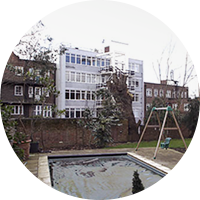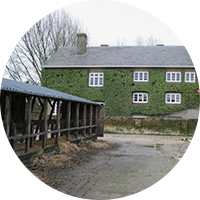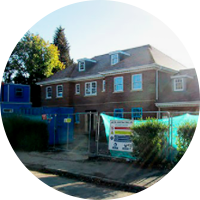
GET IDEAS
Screening Trees
Screening Trees
Majestic Trees has over 12,000 trees in production of all sizes, so whether you want to hide that mobile telephone mast, new high rise or the balcony suddenly appearing that overlooks your back garden, we have the solution. You’ll be amazed at the selection of trees at our nursery that will solve your problems, as so many previous customers have found, having searched the country to no avail, before finding Majestic Trees.
Maybe you are a city dweller who has a small garden and is desperate to hide the neighbours, and wants to sit outside to enjoy the fresh air without feeling that all your neighbours are looking at you? You have a 6 foot fence that you wish was 12 foot, but with pleached (espalier) trees on a 6’ trunk, both deciduous and evergreen, we can provide an aerial hedge that gives you that extra 6’ you need instantly without losing much of your garden! Click though on our home page to ‘Pleached and Topiary’ to find out more, or simply call one of our advisors at 01582-843881 who will guide you to the solutions we can offer.
Or maybe after years of looking out onto the beautiful English countryside, there is a new housing estate appearing in the distance that you never thought would happen? Don’t worry, we can supply and plant a natural corpse or woodland that will make the new housing estate disappear and let you keep the beautiful view you love. All of this and more can be provided by the trees we grow and the team at Majestic Trees.
Five Common Screening Problems and Their Solutions:

Problem One
A large monstrosity, such as an industrial site or high rise block of flats is spoiling my view.
For broadscale screening in a large space, an economical solution is to plant a solid green screen of fast-growing but well-behaved conifers such as Thuja plicata 'Excelsa' (Hedging) or Pinus nigra ssp. nigra , and plant a selection of deciduous trees in front to provide rich contrast and seasonal interest. For a more natural effect, space permitting, a mixed screen of ornamental conifers and deciduous trees can be planted.
For an average sized domestic garden, if screening in excess of 4 meters (approx 12ft) is required, a mixed planting of upright evergreen and deciduous trees is less dominating. For the evergreen element try Thuja plicata 'Excelsa' (Hedging), Calocedrus decurrens, Magnolia grandiflora ‘Goliath’ or Gallissonniere’, or Quercus ilex.
For quite small gardens, or if only ground-floor/garden level screening is needed, see solutions for Problem 3.

Problem Two
Our neighbour’s extension/adjacent property is too imposing or has distant windows which overlook.
If the issue is primarily the unsightly nature and imposition, then a mixed planting of upright evergreen and deciduous trees, as described for Problem #1, can be an attractive solution. Alternatively, a single large evergreen specimen can break up the space and divert the eye.
For larger spaces try Pinus nigra ssp. nigra, Pinus wallichiana or one of the many ornamental Cedars (see link at left).
For medium spaces try Magnolia grandiflora ‘Gallisonniere’ or ‘Goliath’, or for more expansive screening, try planting a row of repeating screening evergreens with a selection of deciduous trees in front for contrast and seasonal interest.
For smaller spaces try evergreens which can be pruned to keep in check, such as Prunus lusitanica, Prunus lusitanica ‘Myrtifolia’, Ligustrum lucidum ‘Excelsum Superbum’, Photinia x fraserii ‘Red Robin’ or Ilex ‘Nellie R. Stevens’. For something a bit more unusual, you might try the highly fragrant try Osmanthus x fortunei, or Camellia japonica in a tree form.
Alternatively, densely branching deciduous trees such as Prunus cerasifera ‘Nigra’, Carpinus betulus ‘Fastigiata’, Acer platanoides ‘Globosum’, or Pyrus calleryana ‘Chanticleer’ can also be effective at breaking up a blank wall whilst still providing seasonal interest. Choose foliage colours which complement or contrast the brickwork and suddenly the offending wall becomes a canvas. For example, dark green foliage contrasts beautifully with orange brick, and red, purple, and jade tones are stunning against gray masonry. White stemmed birch are exquisite against very dark timber or brick.
If there is a definite year-round privacy issue, such as a window (or windows) with an outlook directly into the bedroom, kitchen, etc. then see solutions for Problem #1 or #3, or #4.

Problem Three
I have a six foot fence, but feel overlooked by a neighbours first floor windows.
A tidy, even screen formed by a line of repeating evergreen trees of one variety is an effective and space-saving solution. Classic, economical solutions include Photinia x fraseri ‘Red Robin’ and Ligustrum luc. ‘Excelsum Superbum’.For something a little different but still relatively economical, try Viburnum tinus 'Lucidum'. For a highly ornamental finish, try the highly fragrant Osmanthus x fortunei , a tree form Camellia japonica, or the jolly holly Ilex ‘Nellie R. Stevens’.
For larger spaces, a screen of repeating evergreens can be an effective backdrop for ornamental deciduous trees, or, for a natural, informal finish, try a mixed screen of evergreens and deciduous. See suggestions for Problem #1.
If the budget can accommodate, pleached trees can provide a highly ornamental, containable, and dense screening solution. An increasing number of evergreen options are becoming available, including pleached Magnolia grandiflora, Photinia or Quercus ilex. Panel or box-pleached hornbeam or panel-pleached beech can also be excellent solutions. Although deciduous, they tend to retain their dry leaves through the winter, increasingly so with maturity as the branches become denser, and offer the benefit of seasonal interest.
In cases where it is really only three-season garden privacy that is required (For example when a neighbour’s windows outlook onto one’s garden or patio but not into the house), then glorious options such as Pyrus x call. Chanticleer, Liquidambar styraciflua, and Parrotia persica can be considered. As deciduous trees, they provide seasonal interest, but these species retain their magnificent autumn colours well into December. Pleached and trained versions of many decidious treescanalso be useful, as their branches become quite dense over time, eventually providing a degree of winter privacy too after many years (Pyrus cal. 'Chanticleer' (Pleached), Acer platanoides 'Globosum'). Read more on panel-pleach options under solutions to Problem #5.

Problem Four
I need to block out a single window, or single unsightly object.
Strategic placement of a single carefully chosen specimen usually does the trick.
For small spaces, Photinia x fraserii ‘Red Robin’ or Viburnum tinus 'Lucidum' is an attractive and economical solution. For something a little more dramatic, a formally clipped specimen of Ilex ‘Nellie R. Stevens’ is interesting and containable, as is a tree form Camellia japonica, Osmanthus x fortunei, or Prunus lusitanica.
Where high screening is required in a small space, Calocedrus decurrens is a very slender, attractive conifer, or for an economic solution, Thuja plicata 'Excelsa' (Hedging) is a fairly slender growing, soft conifer which can be contained with light pruning if needed.
For planting spaces which can accommodate an expansive, spreading tree, Quercus ilex, Magnolia grandiflora ‘Gallissonniere’ or ‘Goliath’, or a variety of Cedrus deodara, which are all classic and ornamental options. Quercus ilex and Magnolia grandiflora can be fairly well contained with light regular pruning.

Problem Five
I need screening, but I’m concerned about blocking out light.
In this situation it is important to carefully consider how much and for what months of the year the screening is required. For summer garden screening, the light airy canopy of a Birch or Gleditsia will provide a ‘net curtain’ feeling of seclusion whilst still bathing the garden in dappled light. Where year round privacy is desired, you may be happiest settling for a happy medium. Try a mixed deciduous and evergreen screen as described in Problem #1, taking care on the selection of evergreens to avoid choosing highly vigourous varieties.
An alternative solution is to choose densely branching deciduous trees which can be pollarded to control size. Varieties which lend themselves well to this use are Salix alba ‘Britzensis’, Acer platanoides ‘Globosum’, or ‘Acer platanoides ‘Drumondii’. With increasing maturity and regular pollarding, the crowns will develop dense, compact heads which provide an attractive architectural feature for the garden in all seasons.
Deciduous trees which hold their leaves late into autumn can also provide a delightful solution. Pyrus cal. ‘Chanticleer’ or Parrotia persica provide an exceptional autumn show and often retain their gay apparel well into December, dropping them just in time to let the light stream in during those winter months when the sun is at its lowest.
If the budget will accomodate, panel-pleached trees can certainly offer very elegant screening up to about 3.5 meters. Evergreen varieties now becoming available in this form include Photinia x fraserii ‘Red Robin’, Quercus ilex, and Prunus laur. 'Novita' (Pleached). Hornbeam and beech (Fagus sylvatica (Pleached), Fagus syl. Purpurea Group (Pleached) ) are also stunning options to consider. Although technically deciduous, both tend to retain their coppery dry leaves through the winter with striking effect. The winter screening they provide increases with maturity as the branching structure becomes more dense. Other fantastic deciduous pleaching options are Pyrus cal. ‘Chanticleer’, which offers a stunning spring blossom and fiery autumn colour right through to Christmas, and Tilia x euro. ‘Pallida’, which provides limited winter screening but compensates with its particularly lush, waterfall-effect foliage in summer.
Tackling Your Screening Problem – Where To Start.
Before we start suggesting trees to our customers, we always start by asking the following questions. You’ll see why:
And how near the house would the planting position be? This will impact which varieties will be suitable, so they don’t outgrow the space, and also the planting style and positioning. For example, restricted spaces may lend themselves better to a formal, aerial hedge style of screening, whereas a large open space may suit a mixed, staggered planting of ornamental trees.
and what is the widest ground area to dig into, taking into account fencing, patios, etc. This will limit how mature a specimen can practically be accommodated (although we can overcome many access obstacles with specialist equipment if desired)
Be sure to consider the principles of foreshortening. The closer a tree is planted to the viewing position, the larger it will appear visually (so the smaller the specimen required). Pay careful attention to height of fencing etc compared to length of the trunk of any contenders; sometimes a gap can remain after planting which may be a problem depending on positioning. It’s a good idea to have someone stand in a few possible planting positions and take some photos for a scale reference.
Consider impact on the light into your garden (and neighbours’). Will you be casting yourself into shade? This may influence the size and density of screening trees which will work best. Sometimes very densely branching deciduous trees can provide effective screens yet let still let light through.
For example, are you directly overlooked by a near window, or do you just need to ‘take the edge off’ an overpowering building or structure?
This will influence either the variety of trees you choose (fast or slower growing), and/or the budget you need to achieve that goal.
For lots more evergreen screening suggestions, click here to view our range in Treefinder.
For hedging solutions, click here to view our range in Treefinder.

